Glycolic Acid Exfoliates the Skin, Decreases Skin Oil, Reduces Bacteria, Decreases Hyperpigmentation, and Promotes the Penetration of Acne Medications

The Essential Info
Glycolic acid is an alpha hydroxy acid (AHA) that is used to treat a variety of skin conditions, including acne. It works by:
- Exfoliating the skin
- Decreasing skin oil
- Reducing bacteria
- Decreasing hyperpigmentation
- Promoting the penetration of acne medications
- (unrelated to acne) Reducing signs of skin aging
While glycolic acid is a very welcome adjunct to acne therapy, it will not clear the skin on its own, so it should be combined with other treatments for best results.
Over-the-counter Glycolic Acid: Over-the-counter products can contain up to 10% glycolic acid.
Higher-percentage Glycolic Acid: Higher concentrations of glycolic acid (10 – 70%) must be applied by a skin care professional.
Side Effects: The side effects of glycolic acid are generally mild, and include mild stinging, burning, and itching, but high concentrations administered in doctors’ offices and estheticians’ salons can cause more severe side effects.
DO NOT Use It Every Day: Glycolic acid is powerful. When using over-the-counter glycolic acid products, use it no more than once every other day.

The Science
- Introduction to Glycolic Acid
- How Glycolic Acid Works to Clear Acne
- Glycolic Acid Treatments for Acne
- Characteristics that Affect the Strength of a Glycolic Acid Product
- Glycolic Acid Side Effects
- According to the FDA: Glycolic Acid Does Not Cause Cancer
- How Well Glycolic Acid Works on Acne
Introduction to Glycolic Acid
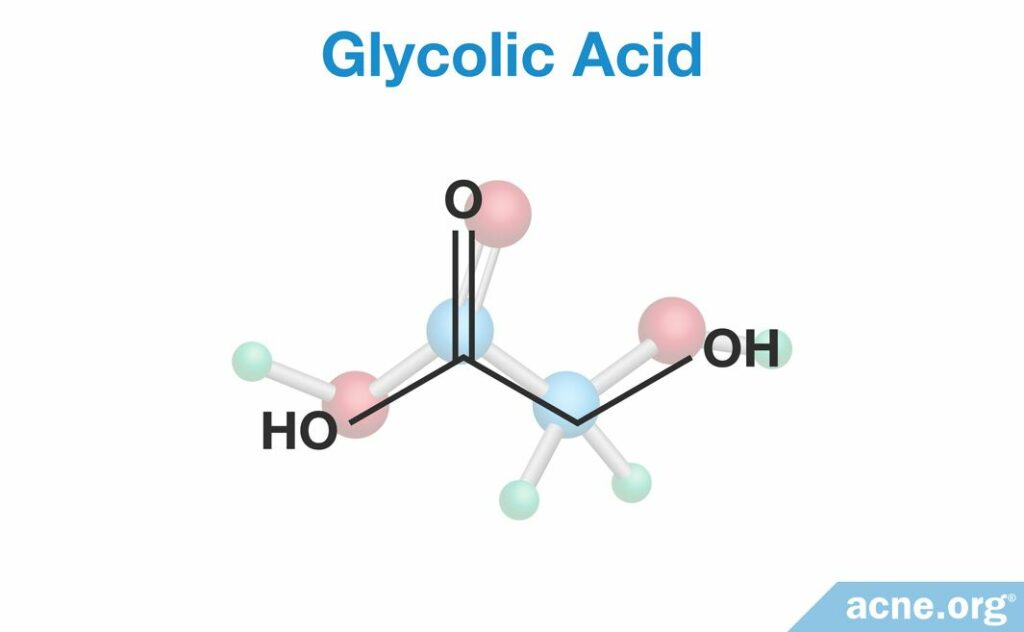
Glycolic acid is an alpha hydroxy acid (AHA), which is a type of acid used to treat a variety of skin conditions, including acne, ichthyosis, keratosis, warts, psoriasis, and sun-damaged skin.
Glycolic acid is the most common AHA used to treat acne, as it was the first AHA scientists discovered, has the most scientific evidence behind it, and is easy to produce. Although it is found naturally in fruits, the glycolic acid used to treat skin diseases is almost always synthetically created in the laboratory in concentrations ranging from 2 – 70%, with over-the-counter products containing up to 10%.
Glycolic acid is effective at clearing acne to some degree but is most effective when used in combination with acne medications instead of as a stand-alone treatment.1,2
How Glycolic Acid Works to Clear Acne
Acne is a disease that results from skin pores becoming clogged with skin oil and dead skin cells. In normal, healthy skin, there is a constant process of skin renewal, where old, dead skin cells flake off the skin and are replaced with new ones. In acne, this process becomes disturbed, and old, dead skin cells accumulate instead of flaking off. The accumulation of these skin cells results in clogged pores, which can then lead to the development of inflammatory acne lesions.
Glycolic acid has several beneficial effects on acne and the skin in general.
Here’s how glycolic acid helps with acne:
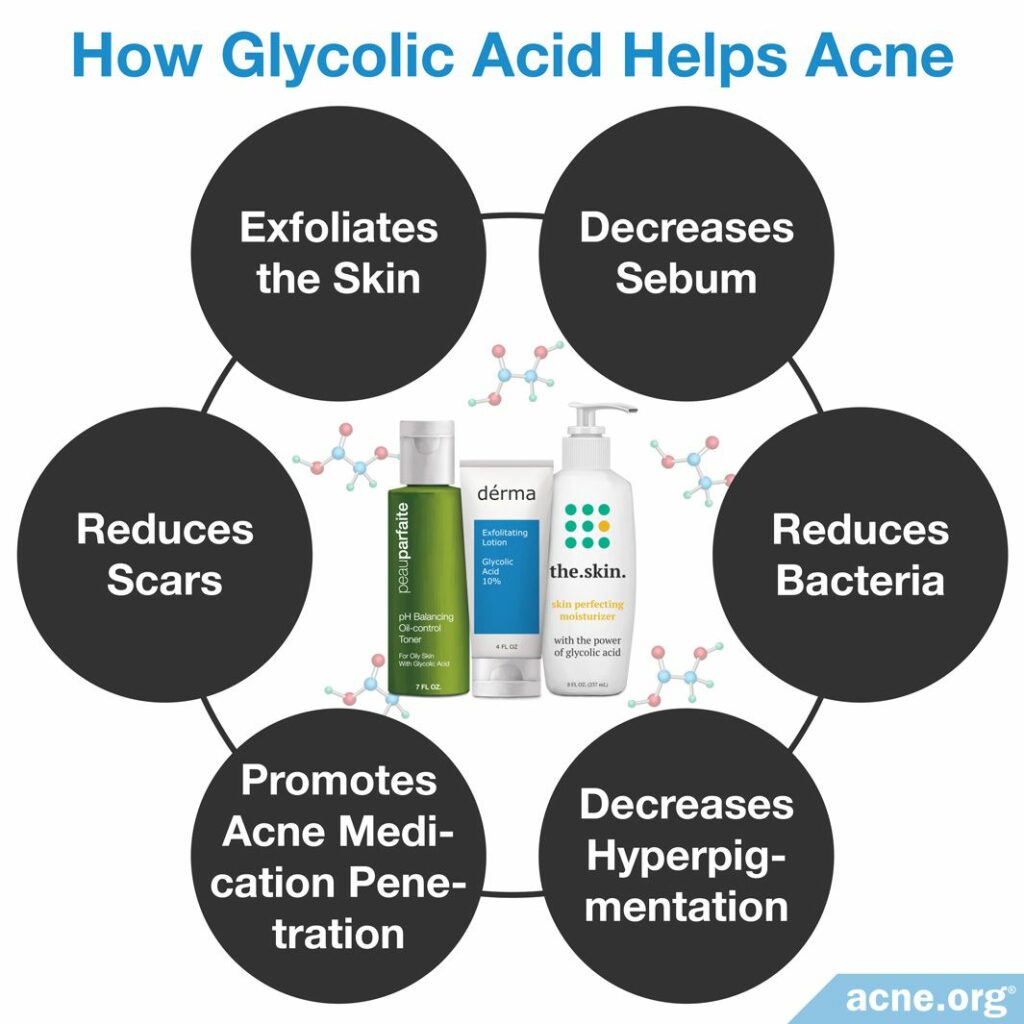
- Exfoliates the skin: The accumulation of dead skin cells on the surface of the skin causes clogged pores and acne. Exfoliation of the skin can thin this layer of dead skin cells, which can help unclog pores that would otherwise develop into comedones (non-inflammatory acne) and potentially more severe forms of acne. Glycolic acids work to exfoliate the skin by:
- Absorbing calcium: Glycolic acid can capture calcium particles. Calcium is an important mineral that binds to the surface of skin cells and helps the cell attach to other cells. Glycolic acid absorbs this calcium so that the calcium is not available to bind to skin cells. This weakens the connections between skin cells, and this helps to exfoliate the skin.
- Breaking down keratin: Skin cells known as keratinocytes produce a “sticky” protein called keratin. Keratin causes skin cells to stick together, and this results in them accumulating on the surface of the skin. Acne-prone individuals often produce more keratinocytes than non-acne-prone individuals, and this leads to more keratin and thus clogged pores and acne. Glycolic acid can break down keratin and “pull apart” skin cells that are stuck together, which helps to clear accumulated cells from the surface of the skin.
- Breaking down surface skin cells: Corneocytes are a type of skin cell that makes up the topmost layer of skin, called the stratum corneum. Glycolic acid promotes the breakdown of corneocytes, and therefore promotes the thinning of the top layer of skin. Removing the corneocytes helps to exfoliate the skin, resulting in fewer clogged pores and less acne.
- Decreases skin oil: Normally, the skin produces skin oil, called sebum, that helps to keep the skin healthy and protected. Acne-prone individuals often produce too much sebum, which can accumulate inside of a clogged pore and cause acne. Glycolic acid can decrease the amount of sebum the skin produces, which would help to prevent the formation of comedones.
- Reduces bacteria: A type of bacteria called C. acnes thrives inside a clogged pore and can rapidly grow inside an acne lesion. This type of bacteria can make acne worse by initiating inflammation, which can make the lesion red, swollen, and sore. This type of bacteria can also trigger the development of pus. Glycolic acid possesses anti-bacterial properties, meaning that it can decrease the amount of C. acnes inside acne lesions.
- Decreases hyperpigmentation: After an acne lesion heals, it leaves behind red/dark marks. Dermatologists call these marks post-inflammatory hyperpigmentation, or just hyperpigmentation for short. Hyperpigmentation is more common in people with non-Caucasian skin. Glycolic acid can decrease hyperpigmentation by stimulating the growth of new skin cells. Skin discoloration decreases because new skin cells rapidly replace the old, discolored cells, which evens out the color of the skin.
- Promotes penetration of acne medications: To be effective at clearing acne, topical acne medications need to penetrate into the skin. A layer of accumulated dead skin cells covering the skin’s surface can prevent medications from penetrating into the skin, which would decrease their effectiveness. Glycolic acid exfoliates the topmost layer of skin, and this allows for topical acne medications to seep into the skin more easily, improving their effectiveness.
- Reduces scars: Severe acne lesions often leave scars. High-percentage glycolic acid peels can help to somewhat reduce scarring from acne lesions.2-6
Glycolic acid also reduces the signs of aging.
Here’s how:
- Thickens skin: In healthy skin, collagen provides support and structure to the skin. If this collagen is damaged, or if the amount of collagen decreases, wrinkles form. Glycolic acid can increase the amount of collagen, which would help the skin maintain its shape and strength.
- Increases hydration: Healthy skin must contain a certain amount of water, and without a proper level of water, it can become dry and flaky. This dryness can lead to skin damage and skin aging. Glycolic acid works to maintain skin moisture by increasing the production of a compound called hyaluronic acid. Hyaluronic acid supports skin hydration, and the increase in moisture improves “skin appearance, texture, and function.”2
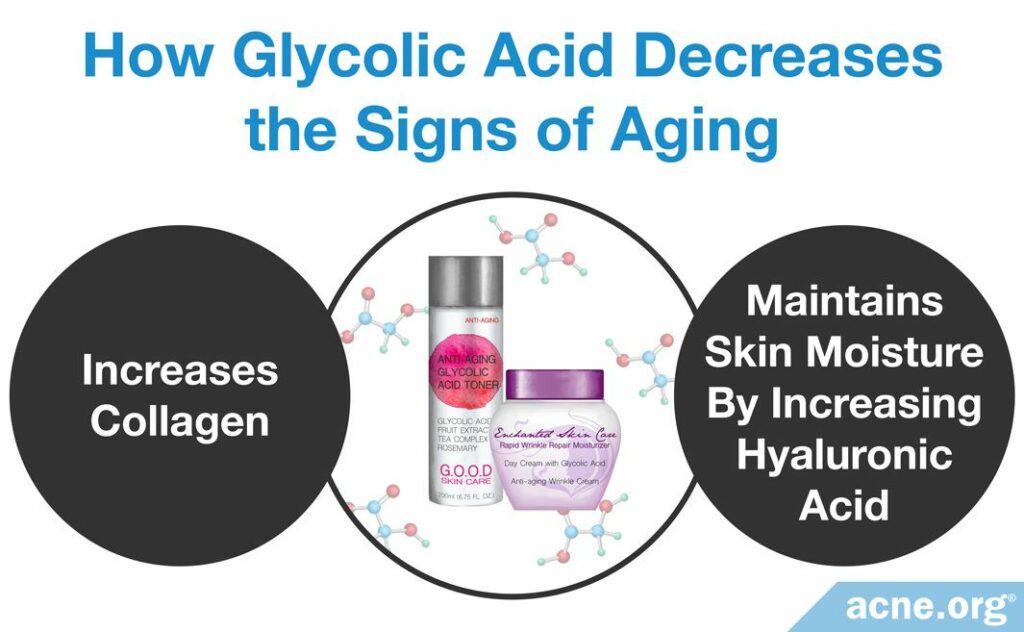
Glycolic Acid Treatments for Acne
Glycolic acid is available as:
- Over-the-counter products
- Professionally-administered chemical peels
Over-the-counter glycolic acid products
Over-the-counter glycolic acid products all contain concentrations up to 10%. These products work by exfoliating the top layer of skin, reducing sebum, and decreasing skin hyperpigmentation. Due to the lower concentration, these products are safe to use at home, and while they can clear acne to some degree on their own, they are normally used alongside established acne medications.
Professionally-administered glycolic acid peels
Glycolic acid can also be applied in the form of a chemical peel. Chemical peels are not over-the-counter and must always be administered by a professional, such as an esthetician/cosmetician, nurse, or doctor. Chemical peels should never be attempted at home. A glycolic acid chemical peel most often contains glycolic acid at a concentration of 20 – 70%. A glycolic acid chemical peel, regardless of strength, works by:
- Exfoliating the skin: Like all glycolic acid products, glycolic acid chemical peels thin the layer of dead skin cells that can accumulate on the surface of the skin. Exfoliating this dead skin cell layer helps to unclog pores.
- Removing the keratin plug: Glycolic acid can break down the “sticky” protein keratin. Keratin works like glue and can stick skin cells together and promote skin cell accumulation on the surface of the skin. High-percentage chemical peels can help remove keratin plugs, which are structures formed from keratin and skin cells that clog the opening of the pore. The formation of a keratin plug can lead to acne, so removing keratin plugs can help prevent acne in the first place.
- Removing the contents of an acne lesion: Removing a keratin plug enables the extrusion of the contents in clogged pores, which helps to clear them from the skin
Professionally-administered glycolic acid peels are effective at improving acne in people with mild-to-moderate acne, but less effective at clearing acne in people with severe forms of acne, including patients who present with several acne nodules and/or acne cysts.3
Characteristics that Affect the Strength of a Glycolic Acid Product
When using glycolic acid to treat acne, there are two factors that can alter its strength:
- Concentration
- pH (how acidic)
Concentration
- Lower concentration – over-the-counter products
Generally, glycolic acid at concentrations up to 10% is safe for more frequent use and light exfoliation of the skin. These concentrations are found in topical medications or other over-the-counter glycolic acid products available for daily or recurrent use. - Higher concentration – professionally-administered peels
Professionally-administered glycolic acid products range in concentration of 20 – 70%. Glycolic acid products at these high concentrations are available in the form of deep chemical peels, and should never be applied at home.2,7
pH
pH is a scientific unit that measures the acidity of a compound. The pH scale ranges from 1 – 14, with “1” representing the most acidic substance and “14” representing the least acidic substance. For example, stomach acid has a pH of 2; water has a neutral pH of 7, and bleach has a pH of 12. The pH of the glycolic acid product can impact what effects it has on the skin and on acne. The lower the pH, the more effective glycolic acid is at clearing acne. There is also some evidence that a lower pH increases the ability of glycolic acid to fight acne bacteria.7 However, a low pH also causes more side effects.
- Higher pH – over-the-counter products
The Food and Drug Administration (FDA) has determined the glycolic acid used for over-the-counter treatment of acne or other skin diseases must have a pH of 3.5 or greater - Lower pH – professionally-administered peels
Professionally-administered glycolic acid chemical peels can have a pH of 2 or lower. However, this low pH can lead to more severe side effects, and due to these side effects, only professionals should perform such chemical peels.2,8
Glycolic Acid Side Effects
The side effects of glycolic acid products are generally mild, but professionally-administered glycolic acid chemical peels can have more severe side effects.
Side effects of over-the-counter products
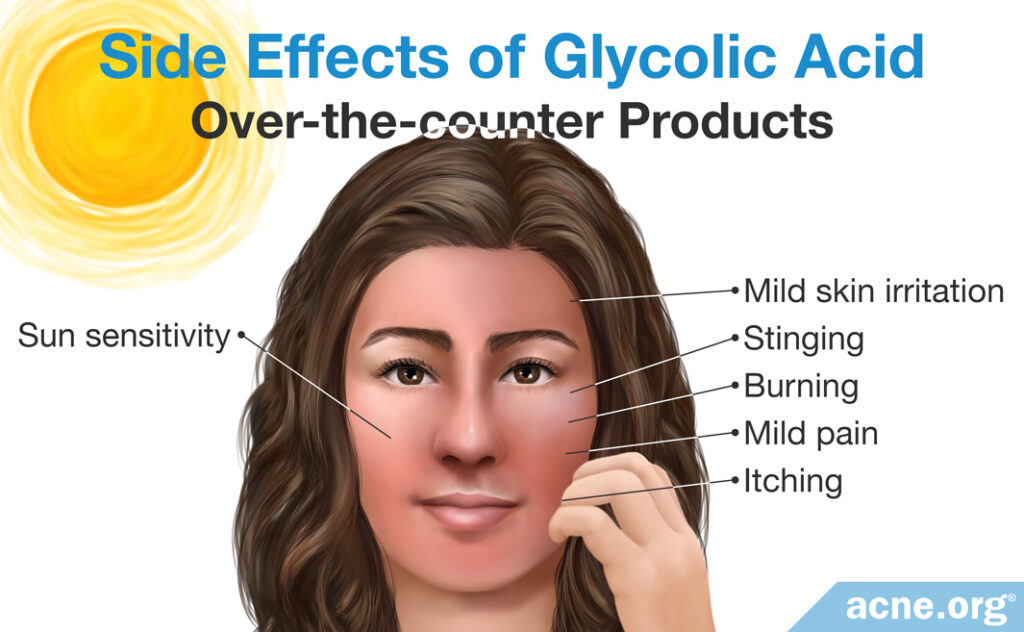
Over-the-counter glycolic acid products may cause some mild side effects, including:
- Mild skin irritation
- Stinging
- Burning
- Mild pain
- Itching
Important! Sun sensitivity: Increased sun sensitivity means that the skin is more prone to sunburn. Therefore, the FDA recommends that those using glycolic acid always wear some form of sun protection for the entire duration of treatment and for at least one week post-treatment.2,9
DO NOT use it every day: Glycolic acid is powerful, even when it is in over-the-counter products. Use it no more than once every other day.
Side effects of professionally-administered peels
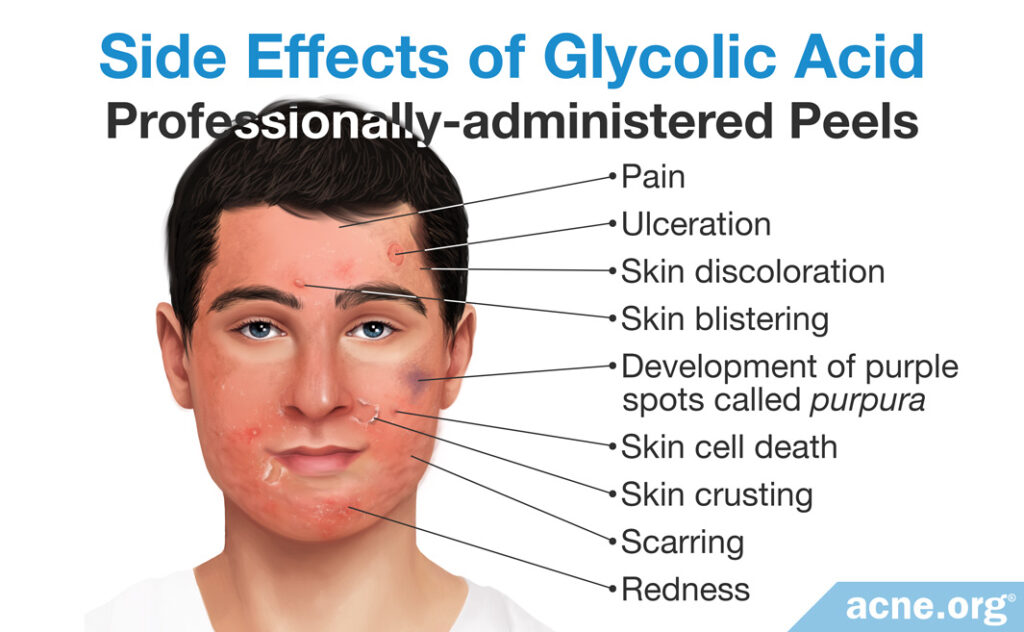
Glycolic acid at high concentrations and a low pH can cause much more serious side effects, including:
- Pain
- Skin blistering
- Development of purple spots called purpura
- Skin crusting
- Redness
- Skin discoloration
- Skin cell death
- Ulceration
- Scarring
Due to the more severe side effects, only professionals should administer high-concentration glycolic acid peels. If they were to be done at home and something went amiss, the person could hurt him/herself.8
According to the FDA: Glycolic Acid Does Not Cause Cancer
Since glycolic acid can make the skin more prone to sunburn, several studies have investigated whether it can make the skin more prone to developing cancer.
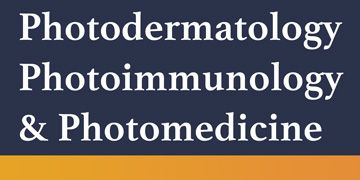
A 2003 study published in Photodermatology, Photoimmunology and Photomedicine tested the ability of glycolic acid to cause cancer in mice. This study concluded that glycolic acid did not cause cancer in mice.
Further, the FDA has evaluated the cancer-causing ability of all AHAs, including glycolic acid, and determined, “[A]HA ingredients are not mutagenic or carcinogenic, are not reproductive or developmental toxins, and are not skin sensitizers.” In other words, AHAs, including glycolic acid, do not cause cancer and do not affect pregnancy.2
How Well Glycolic Acid Works on Acne
There are several studies investigating the effectiveness of both over-the-counter products and professionally-administered peels on acne.1,3,10-15
Expand to read details of studies on over-the-counter glycolic acid products
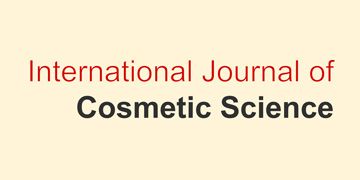
A 2015 study published in the International Journal of Cosmetic Science investigated the effectiveness of a 4% glycolic acid solution at clearing acne in 23 female acne patients. This study was performed through daily use of the 4% glycolic acid solution over the course of 4 weeks. The researchers found that the 4% glycolic acid treatment reduced non-inflammatory acne (whiteheads and blackheads) by 7.6% over 4 weeks. It is important to note that this study looked at glycolic acid as a sole treatment. In real life, glycolic acid is often combined with acne medications to achieve a better result.10

A 2022 study published in the Chinese Medical Journal tested the efficacy and safety of 5% glycolic acid on 40 acne patients. The patients applied a 5% glycolic acid peel to their skin once a day for 70 days.The researchers examined the patients’ skin before and after the treatment period and compared the number of acne lesions. They found that on average, the total number of acne lesions decreased by 27.6% over the 70 days of treatment. The treatment also improved skin hydration and decreased the size of skin pores. The patients rated their satisfaction with the 5% glycolic acid treatment as 3.25 out of 4, on average. Five out of the 40 patients experienced side effects, but the study does not provide details on what these side effects were. However, none of the patients chose to quit the study early due to side effects.11
Expand to read details of studies on professionally-administered glycolic acid peels

A 1999 study published in the Journal of the European Academy of Dermatology and Venereology investigated the efficacy of a 70% glycolic acid peel at clearing acne in 80 female acne patients. This study found that a 70% glycolic acid peel rapidly improved mild to moderate acne, and that it took an average of 6 peels to clear up moderate to severe acne. For severe acne with multiple acne nodules and cysts, the patients needed 8 – 10 peels before they observed an improvement in acne (moderate improvement in 5% of patients and marked improvement in 95% of patients) and acne scarring.12

A 1999 study published in the journal Dermatologic Surgery compared the efficacy of a 70% glycolic acid peel with another professionally-administered peel called Jessner’s solution. The researchers treated 26 Asian male and female patients with facial acne with the glycolic acid peel on one side of the face and Jessner’s solution on the other side of the face. Patients received 3 peel treatments at 2-week intervals, and the researchers compared the results and side effects on the two sides of the face. The scientists found that while both the glycolic acid peel and Jessner’s solution were equally effective, glycolic acid caused fewer side effects. In addition, when asked about which treatment they preferred, 50% of patients chose glycolic acid, 30% had no preference, and only 20% preferred Jessner’s solution. The researchers’ wrote, “Glycolic acid peeling was the patients’ treatment of choice for the future.”13

A 2003 study published in the Indian Journal of Dermatology, Venereology and Leprology tested glycolic acid peels on 41 male and female patients with medium-to-dark skin. Sixteen of these patients suffered from acne: 8 had mild-to-moderate acne, 7 patients had severe acne, and 1 patient had nodulocystic acne. In addition, multiple patients had scarring and hyperpigmentation. Initially, the researchers treated the patients with 10% glycolic acid peels for 1-2 minutes, and then gradually increased the duration of treatment to 5 minutes as well as the concentration of glycolic acid to 30%. Treatments were performed every 2 weeks. The scientists found glycolic acid peels effective in 75% of patients with acne. In addition, the glycolic acid peels improved scars and hyperpigmentation. However, the patient with nodulocystic acne experienced no improvement.14

A 2008 study published in Dermatologic Surgery investigated the effectiveness of a 30% glycolic acid peel at clearing acne in 20 acne patients. This study used 6 peels performed at 2-week intervals over 12 weeks. The researchers concluded that the 30% glycolic acid peel reduced the inflammatory acne lesion (papule and pustule) count by 43%.1
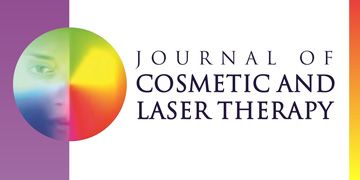
A 2010 study published in the Journal of Cosmetic Laser Therapy investigated the effectiveness of several different glycolic acid peel concentrations at clearing acne in 24 male and female acne patients. This study used 12 peels performed at 2-week intervals over 6 months. The researchers found that the average number of acne lesions decreased from 47 to 17, which is a 63% reduction. The number of inflammatory acne lesions reduced by 29.1%, and the number of non-inflammatory acne lesions reduced by 62.7%.15

A 2011 study published in the Journal of the European Academy of Dermatology and Venereology compared several studies investigating the effectiveness of glycolic acid peels at treating acne. This comparison led the researchers to draw four conclusions regarding the efficacy of glycolic acid peels.
1. The researchers found that the higher the concentration of glycolic acid, the more effective the peel was at clearing acne
2. The researchers concluded that as the number of peels performed on a patient increased, so did the efficacy, meaning that more peels provided better results
3. The researchers concluded that glycolic acid peels are most effective at treating mild acne, but can also help clear more severe acne. Acne was moderately improved in both groups, more than 0.5 improvement on a 0 – 5 acne grade in 50% of patients.
4. The researchers found that in some patients there was a flare of acne immediately following the beginning of treatment, meaning that the acne could get worse before it gets better3

A 2022 study published in the Chinese Medical Journal tested a 20% glycolic acid peel on 40 patients with acne. The patients received 4 treatment sessions spaced 2 weeks apart. The researchers examined the patients’ skin before and after the treatment period and compared the number of acne lesions. They found that on average, the total number of acne lesions decreased by 18.8% over the course of treatment. The glycolic acid peels also improved skin hydration and decreased the size of skin pores. The patients rated their satisfaction with the 20% glycolic acid treatment as 2.78 out of 4, on average. Eight out of the 40 patients experienced side effects, which affected their satisfaction rating. However, none of the patients chose to drop out of the study early due to side effects.11
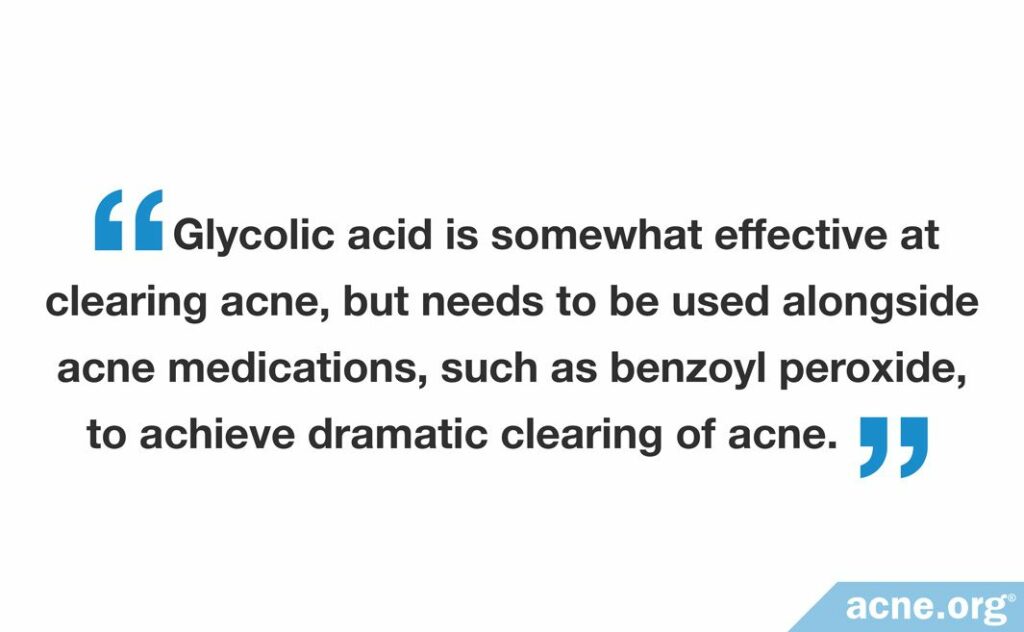
From this data, we can conclude that over-the-counter glycolic acid is somewhat effective at clearing acne, but needs to be used alongside acne medications, such as benzoyl peroxide, to achieve dramatic clearing of acne. On the other hand, professionally-administered glycolic acid peels may produce more significant results than over-the-counter glycolic acid. However, to achieve complete clearing of the skin, either type of glycolic acid should be combined with other treatments.
References
- Kessler, E., Flanagan, K., Chia, C., Rogers, C. & Glaser, D. A. Comparison of α- and β-hydroxy acid chemical peels in the treatment of mild to moderately severe facial acne vulgaris. Dermatol Surg 34, 45 – 51 (2008). https://www.ncbi.nlm.nih.gov/pubmed/18053051
- Kornhauser, A., Coelho, S. G. & Hearing, V. J. Applications of hydroxy acids: classification, mechanisms, and photoactivity. Clin Cosmet Investig Dermatol 3, 135 – 142 (2010). https://www.ncbi.nlm.nih.gov/pmc/articles/PMC3047947/
- Dréno, B. et al. Efficacy of superficial chemical peels in active acne management – What can we learn from the literature today? Evidence-based recommendations. J Eur Acad Dermatol Venereol 25, 695 – 704 (2011). https://www.ncbi.nlm.nih.gov/pubmed/21029205
- Abdel Hay, R. et al. Cochrane Database of Systematic Reviews. 4, 1 – 45 (2016). https://www.cochranelibrary.com/cdsr/doi/10.1002/14651858.CD011946.pub2/references
- Garg, V. K., Sinha, S. & Sarkar, R. Glycolic acid peels versus salicylic-mandelic acid peels in active acne vulgaris and post-acne scarring and hyperpigmentation: a comparative study. Dermatol Surg 35, 59 – 65 (2009). https://www.ncbi.nlm.nih.gov/pubmed/19076192
- Erbagci, Z. & Akcali, C. Biweekly serial glycolic acid peels vs. long-term daily use of topical low-strength glycolic acid in the treatment of atrophic acne scars. Int J Dermatol 39, 789 – 794 (2000). https://www.ncbi.nlm.nih.gov/pubmed/11095203
- Valle-González, E. R., Jackman, J. A., Yoon, B. K., Mokrzecka, N. & Cho, N. J. pH-dependent antibacterial activity of glycolic acid: Implications for anti-acne formulations. Sci Rep 10, 7491-7499 (2020). https://pubmed.ncbi.nlm.nih.gov/32367064/
- FDA. Alpha-Hydroxy Acids. https://www.fda.gov/cosmetics/productsingredients/ingredients/ucm107940.htm#q6
- Babilas, P., Knie, U. & Abels, C. Cosmetic and dermatologic use of alpha hydroxy acids. J Ger Soc Dermatol 10, 488 – 491 (2012). https://www.ncbi.nlm.nih.gov/pubmed/22916351
- Kim, S. J. et al. The effect of physically applied alpha hydroxyl acids on the skin pore and comedone. Int J Cosmet Sci 37, 519 – 525 (2015). https://www.ncbi.nlm.nih.gov/pubmed/26032934
- Zhao, J., Zhou, B., Hou, Y., Li, L. & Zhuo, F. Effect of 5% glycolic acid complex and 20% glycolic acid on mild-to-moderate facial acne vulgaris. Chin Med J (Engl) 135, 2614-2616 (2022). https://pubmed.ncbi.nlm.nih.gov/36583924/
- Atzori, L., Brundu, M. A., Orru, A. & Biggio, P. Glycolic acid peeling in the treatment of acne. J Eur Acad Dermatol Venereol 12, 119 – 122 (1999). https://www.ncbi.nlm.nih.gov/pubmed/10343939
- Kim, S. W., Moon, S. E., Kim, J. A. & Eun, H. C. Glycolic acid versus Jessner’s solution: which is better for facial acne patients? A randomized prospective clinical trial of split-face model therapy. Dermatol Surg 25, 270 – 273 (1999). https://pubmed.ncbi.nlm.nih.gov/10417580/
- Grover, C. & Reddu BS. The therapeutic value of glycolic acid peels in dermatology. Indian J Dermatol Venereol Leprol 69, 148 – 150 (2003). https://pubmed.ncbi.nlm.nih.gov/17642863/
- Ilknur, T., Demirtaşoğlu, M., Biçak, M. U. & Ozkan, S. Glycolic acid peels versus amino fruit acid peels for acne. J Cosmet Laser Ther 12, 242 – 5 (2010). https://www.ncbi.nlm.nih.gov/pubmed/20825257
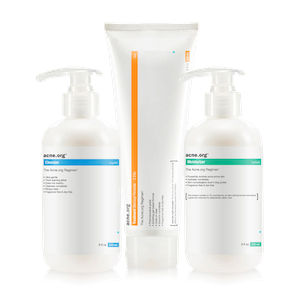 Acne.org Products
Acne.org Products